2013年10月28日
Awashima Snapshots
Takamatsu makes a great base for enjoying islands and art in the Setouchi Triennale. The final week of this contemporary art festival has been fair and beautiful. I spent these last lovely days joining the hordes of visitors to the 3 islands only open during the Autumn Session. There is far, far too much to see and enjoy, so I will content myself here with sharing just a few snapshots. Let me start with Awashima.

9 AM waiting with several hundred people for a boat that carries only 70 passengers – a great time to chat and make friends.

The boats are crowded but friendly.
Recognizing that the point of this contemporary art festival is to enjoy the islands, we decided to forgo waiting in line with the hordes to see manmade art and instead climbed the peak behind the village to see nature’s art. At 220 meters it was a stiff half-hour climb

and we were hot and sweaty at the top despite the cool autumn weather.

But we had been lured by promises of the 360-degree view and we were not disappointed. The shot below shows Takamajima, the next island on our itinerary.
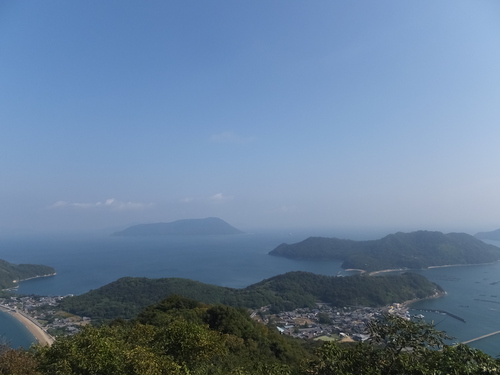
Back at the bottom, we stopped at an art site or two, much less crowded because most people had passed on. The work, Susanoo, which is like walking into a dark cobwebby cave on the first floor, caught my fancy.
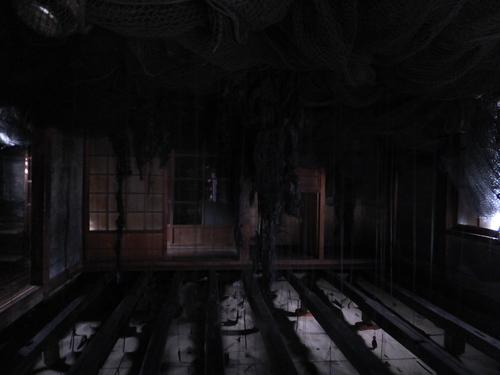
I particularly enjoyed the “art” on the second floor – the thrifty habit of long deceased residents of patching their doors with used letters and newspapers resulted in gorgeous collages that gave the room a nostalgic feel.


Here’s another door that caught my fancy.

Made from a single tree trunk that has been split open like a book. Yes, I know it’s not contemporary art but it is part of the “art” of living and as such is most relevant to this art festival. The Triennale uses art as a vehicle to draw people’s attention to the beauty of what is already there.
Here’s another form of art that you won’t find in most contemporary art exhibits. Homemade sandwiches and gingerale.
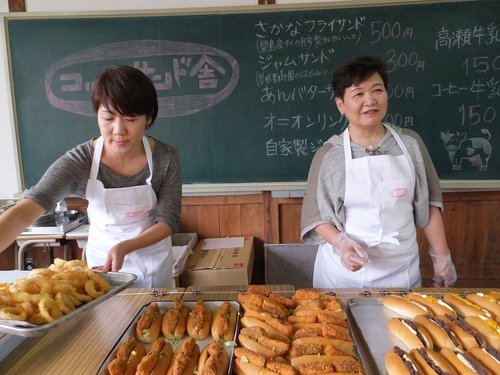

Delicious but how is it art? The food designer and creator studied the area’s products and cuisine, revived a much loved bread roll and stuffed it with local ingredients: freshly caught, deep fried fish fillets and tartar sauce, and cream cheese with either sweet bean jam or marmalade made with locally grown oranges. Mmmm. The “artist’s” goal was to capture people’s hearts and imaginations through their stomachs and she did a good job. The food was all served on tin dishes from the school.
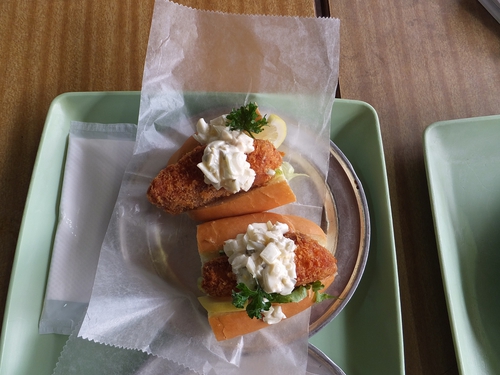
I had been fortunate to try her “art” early in the season before the crowds. In this last week, however, people were lining up for an hour ahead of time to get some, so we opted to enjoy the fare offered at the many booths put up by local chambers of commerce, women’s organizations, young entrepreneurs and others. My favorite was tempura dried anchovies produced by a mother and son from Ibukijima island where anchovy production is the main industry.
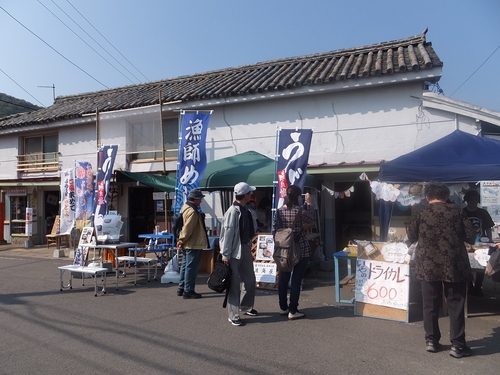
All in all, it was a great way to spend the morning, and we could have stayed all day. The islanders were very open and friendly. They seemed more accustomed to visitors than the other islands, perhaps because the former marine school had students boarding from all over Japan, and many of the local sailors traveled the world. Here are some parting shots.

The old marine school
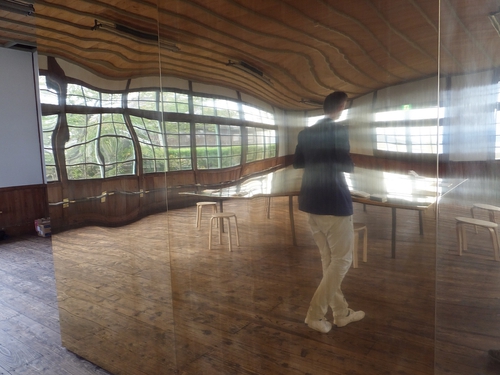
The Sea Library with the artist reflected in the locally made brass partition.
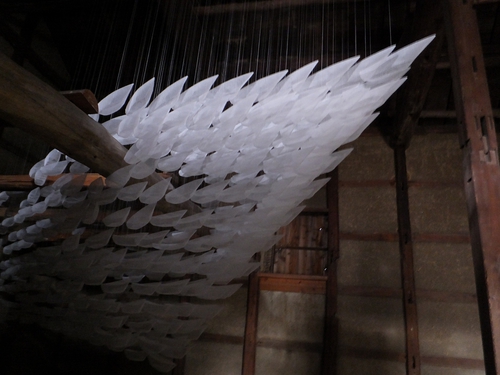
Embarkation, in which artist Syoko Aso expressed her hopes for the islanders to sail on into the future.
For more on the Triennale, see http://setouchi-artfest.jp/en/
Takamatsu Access:
Takamatsu can be reached by direct flights from Tokyo’s Haneda Airport, by express bus from Kansai International Airport (3 hr), and by direct flights from China and Korea. It can also be reached by taking the bullet train to Okayama and changing to the Marine Liner bound for Takamatsu (runs every 1/2 hour; takes 1 hour). For more info see http://wikitravel.org/en/Takamatsu

9 AM waiting with several hundred people for a boat that carries only 70 passengers – a great time to chat and make friends.

The boats are crowded but friendly.
Recognizing that the point of this contemporary art festival is to enjoy the islands, we decided to forgo waiting in line with the hordes to see manmade art and instead climbed the peak behind the village to see nature’s art. At 220 meters it was a stiff half-hour climb

and we were hot and sweaty at the top despite the cool autumn weather.

But we had been lured by promises of the 360-degree view and we were not disappointed. The shot below shows Takamajima, the next island on our itinerary.

Back at the bottom, we stopped at an art site or two, much less crowded because most people had passed on. The work, Susanoo, which is like walking into a dark cobwebby cave on the first floor, caught my fancy.

I particularly enjoyed the “art” on the second floor – the thrifty habit of long deceased residents of patching their doors with used letters and newspapers resulted in gorgeous collages that gave the room a nostalgic feel.


Here’s another door that caught my fancy.

Made from a single tree trunk that has been split open like a book. Yes, I know it’s not contemporary art but it is part of the “art” of living and as such is most relevant to this art festival. The Triennale uses art as a vehicle to draw people’s attention to the beauty of what is already there.
Here’s another form of art that you won’t find in most contemporary art exhibits. Homemade sandwiches and gingerale.


Delicious but how is it art? The food designer and creator studied the area’s products and cuisine, revived a much loved bread roll and stuffed it with local ingredients: freshly caught, deep fried fish fillets and tartar sauce, and cream cheese with either sweet bean jam or marmalade made with locally grown oranges. Mmmm. The “artist’s” goal was to capture people’s hearts and imaginations through their stomachs and she did a good job. The food was all served on tin dishes from the school.

I had been fortunate to try her “art” early in the season before the crowds. In this last week, however, people were lining up for an hour ahead of time to get some, so we opted to enjoy the fare offered at the many booths put up by local chambers of commerce, women’s organizations, young entrepreneurs and others. My favorite was tempura dried anchovies produced by a mother and son from Ibukijima island where anchovy production is the main industry.

All in all, it was a great way to spend the morning, and we could have stayed all day. The islanders were very open and friendly. They seemed more accustomed to visitors than the other islands, perhaps because the former marine school had students boarding from all over Japan, and many of the local sailors traveled the world. Here are some parting shots.

The old marine school

The Sea Library with the artist reflected in the locally made brass partition.

Embarkation, in which artist Syoko Aso expressed her hopes for the islanders to sail on into the future.
For more on the Triennale, see http://setouchi-artfest.jp/en/
Takamatsu Access:
Takamatsu can be reached by direct flights from Tokyo’s Haneda Airport, by express bus from Kansai International Airport (3 hr), and by direct flights from China and Korea. It can also be reached by taking the bullet train to Okayama and changing to the Marine Liner bound for Takamatsu (runs every 1/2 hour; takes 1 hour). For more info see http://wikitravel.org/en/Takamatsu
My Profile
Cathy Hirano キャシー ヒラノ
I've lived in Japan since 1978. After graduating from a Japanese university with a BA in cultural anthropology in 1983, I worked as a translator in a Japanese consulting engineering firm in Tokyo for several years. My Japanese husband and I moved to Takamatsu in 1987 to raise our two children in a slower-paced environment away from the big city pressures. We've never regretted it. I work as a freelance translator and interpreter and am involved in a lot of community work, including volunteering for Second Hand, a local NGO that supports educational and vocational training initiatives in Cambodia, and for the Takamatsu International Association. I love living in Takamatsu.
Cathy Hirano キャシー ヒラノ
I've lived in Japan since 1978. After graduating from a Japanese university with a BA in cultural anthropology in 1983, I worked as a translator in a Japanese consulting engineering firm in Tokyo for several years. My Japanese husband and I moved to Takamatsu in 1987 to raise our two children in a slower-paced environment away from the big city pressures. We've never regretted it. I work as a freelance translator and interpreter and am involved in a lot of community work, including volunteering for Second Hand, a local NGO that supports educational and vocational training initiatives in Cambodia, and for the Takamatsu International Association. I love living in Takamatsu.
Posted by cathy at 12:46│Comments(5)
この記事へのコメント
Hi Cathy,
Glad to see you got to enjoy some island time this Fall.
Funny seeing your pictures as the only three things I missed on Awashima were Embarkation, Susanoo and the sandwiches (we didn't have enough time on the island - big mistake - and were planning on returning last week-end, didn't happen).
I was also intrigued by Awashima, as it looks much less abandoned than all of the other islands (I'm not even sure I've seen one single abandoned house in the main village, quite a contrast with Takamijima).
I can't wait to return to these islands when the festival and hordes of visitors are gone.
What are your plans for the final week-end?
I'll be on Shodoshima on Sunday (mostly in Mito peninsula) and on Ogijima (of course) on Monday. :-)
Glad to see you got to enjoy some island time this Fall.
Funny seeing your pictures as the only three things I missed on Awashima were Embarkation, Susanoo and the sandwiches (we didn't have enough time on the island - big mistake - and were planning on returning last week-end, didn't happen).
I was also intrigued by Awashima, as it looks much less abandoned than all of the other islands (I'm not even sure I've seen one single abandoned house in the main village, quite a contrast with Takamijima).
I can't wait to return to these islands when the festival and hordes of visitors are gone.
What are your plans for the final week-end?
I'll be on Shodoshima on Sunday (mostly in Mito peninsula) and on Ogijima (of course) on Monday. :-)
Posted by David at 2013年11月01日 23:55
David, Great to hear from you!! I'm so glad you are getting to the islands, too. And I'm glad to hear you saw what I didn't which means that I'll be able to catch up on them on your blog.
I can't go this weekend at all which is why I went during the week. How I wish I was going to Ogijima on Monday. Maybe I can squeeze it in a quick morning trip, if the ferry line up isn't too long.
Awashima does have quite a different feel, doesn't it? And you're right, there didn't seem to be many noticeable abandoned buildings. Maybe because it's been used as a resort for quite sometime in addition to having more contact with the rest of the world through the school and sailors.
I'm looking forward to revisiting these islands when it's over, too.
I can't go this weekend at all which is why I went during the week. How I wish I was going to Ogijima on Monday. Maybe I can squeeze it in a quick morning trip, if the ferry line up isn't too long.
Awashima does have quite a different feel, doesn't it? And you're right, there didn't seem to be many noticeable abandoned buildings. Maybe because it's been used as a resort for quite sometime in addition to having more contact with the rest of the world through the school and sailors.
I'm looking forward to revisiting these islands when it's over, too.
Posted by cathy at 2013年11月02日 00:21
at 2013年11月02日 00:21
 at 2013年11月02日 00:21
at 2013年11月02日 00:21A wonderful blog on this very interesting island and history, Cathy. Well done!
Posted by pat scanlon at 2013年11月16日 08:18
Thanks for dropping by, Pat!
Posted by cathy at 2013年11月19日 23:45
at 2013年11月19日 23:45
 at 2013年11月19日 23:45
at 2013年11月19日 23:45Interesting to learn the travel routes to arrive to this part of Japan.
Thank you for photos
Caroline, Port Elgin, Ontario
Thank you for photos
Caroline, Port Elgin, Ontario
Posted by virtual travel at 2014年11月11日 14:21
※会員のみコメントを受け付けております、ログインが必要です。





